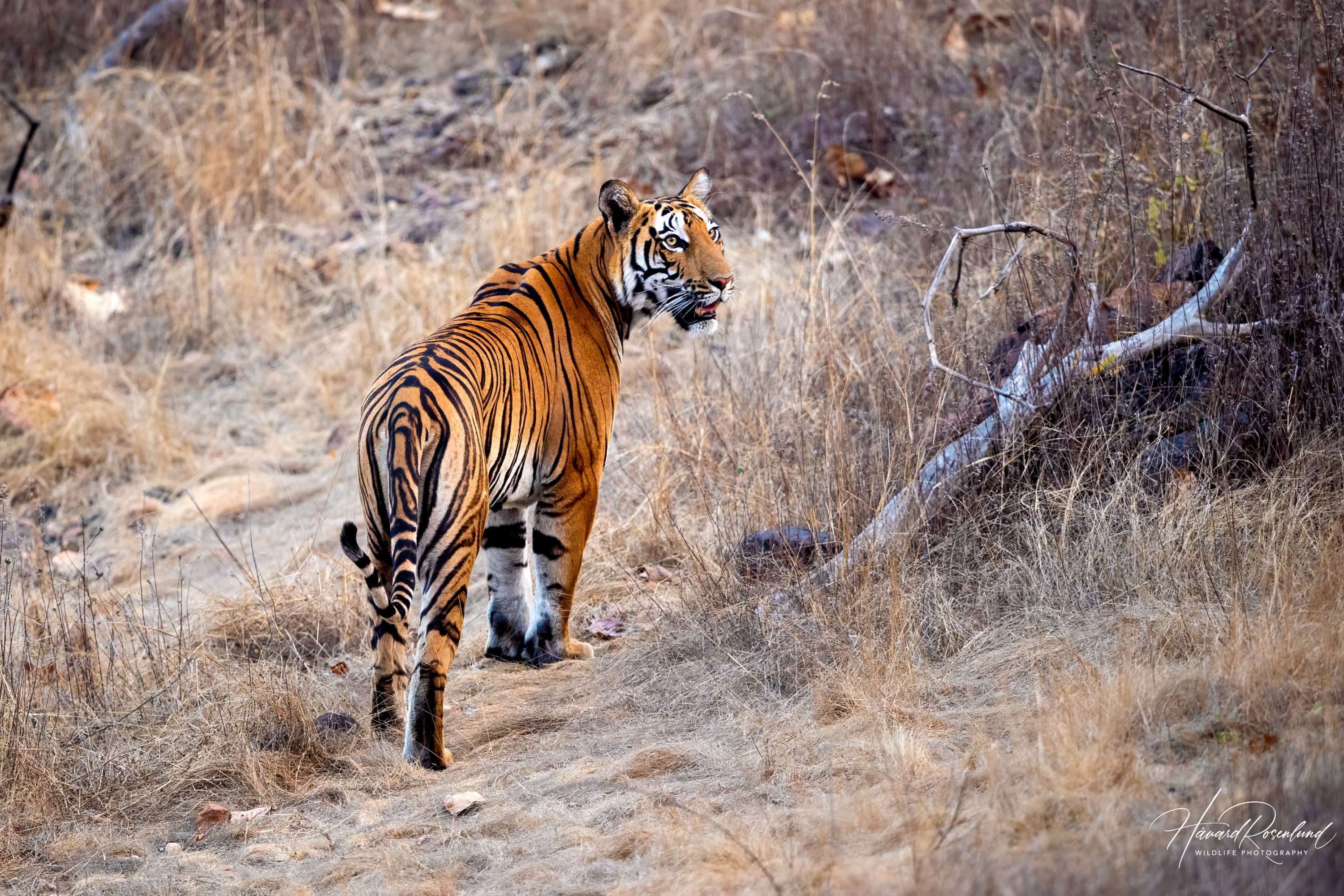Description
The tiger (Panthera tigris) is a big cat found in South Asia, Southeast Asia (including the island of Sumatra), as well as eastern China and Russia (possibly also North Korea). It is the largest of all cat species. Size differs between populations and subspecies. Captive Siberian tigers are known to be the largest, with males reaching weights of more than 300 kg (660 lbs). Typical size for a male ranges from 180 kg to 300 kg (400-660 lbs). Females are smaller and weigh 100-150 kg (220-330 lbs). A large male can measure up to 330 cm (10 ft 10 in) in length from head to tail. In the wild the Bengal tigers of India are known be the largest. They live in more prey rich areas than the wild Siberian tigers of eastern Russia and China, and food availability impacts size. The Sumatran tiger is the smallest, with males typically reaching weights of around 120 kg (260 lbs).
The tiger is a striking and beautiful big cat. It has an orange coat with black stripes, and white coloration on legs, underparts, and face. The Sumatran tiger typically has a darker orange coat and more stripes than the mainland tigers. A rare genetic mutation causes some individuals to be all white with black stripes, a condition different from albinism. This is extremely rare in the wild, and all captive white tigers are likely descendants of the same individual. This white tiger, named Mohan, was captured in what is now known as Bandhavgarh National Park in central India in 1951. No white tigers have been seen in the wild for 50 years.
Habitat & Behavior
Tigers are typically found in forested habitats, such as rainforests, dry deciduous forests, temperate forests, and boreal forests. They can also be found in more open habitats, such as grasslands and savannas, as long as the grass is tall enough to provide cover. The Siberian tiger, which is mainly found in the boreal forests of eastern China and Russia, have thicker fur than other tigers to cope with cold and snowy winters. The tiger is also one of the few cat species that likes to spend time in water. It readily swims and often relaxes in water to cool down on hot days.
Tigers are apex predators, and at the very top of the food chain in any ecosystem they call home. Even though crocodiles, elephants, bears, and packs of dholes (Asiatic wild dogs) can pose as threats, their only real enemy is man. In areas where they do not feel threatened by humans, such as various national parks where tigers are habituated to tourism, they are often seen walking on roads and pathways at all hours of the day. Although they are typically more active at night than during the day, especially when hunting, they often move during hot days to seek shade and water holes to cool down in.
Hunting & feeding habits
Tigers are ambush predators, which means they need to get quite close to their prey before initiating an attack. This is one of the main reasons why they prefer forest habitats, as forests provide sufficient cover for ambush hunting. A tiger relies on stealth and camouflage as it tries to get as close as possible to its prey before it pounces. It normally stalks its prey in dense vegetation, but it can also stalk prey by swimming in water. Although it is not as common, a tiger can give chase and run after its prey. With speeds up to 65 km/h (40 mph) it is definitely a fast animal, but it may have problems catching often faster and/or more agile prey species. Most chases are done if the prey is already weakened or injured.
As is common with many cat species, tigers are opportunistic and will try to catch anything that moves and can be eaten. However, they are not very successful hunters, as only 10-20% of all hunts succeeds. Their diet consists predominantly of various deer species and other ungulates, such as antelopes and wild boar, but as they are opportunistic, they also eat small rodents, monkeys, birds, amphibians, and even fish, given the opportunity. As tigers are very powerful apex predators, they even hunt and eat other large predators, such as crocodiles, leopards, and sloth bears. They are also known to scavenge and steal prey from other predators from time to time.
Medium sized ungulates, such as chital deer and wild boar, are typically common prey species in India, but if they have the opportunity, they prefer larger prey such as the sambar deer (the largest deer in southern Asia). Large prey, such as sambar (weighing up to 300 kg (600 lbs)), will keep a tiger fed for 4-6 days, whereas a chital (80 kg (175 lbs)) only lasts for a day or two. They are also known to hunt and kill adult gaur, the largest wild bovine in the world, with weights reaching up to 1,500 kg (3300 lbs) for large bulls. In comparison, a Cape buffalo bull in Africa can weigh up towards 900 kg (almost 2000 lbs), and it typically takes a whole pride of lions to kill one of those.
Social behavior & Reproduction
Except when females have cubs and during times of mating, tigers are solitary animals. Males have large territories, often encompassing several smaller female territories. The size of a territory depends on the availability of prey. In an area with plenty of suitable prey, such as many national parks of central India, the size of a territory may be as small as 30 km² for males and 10 km² for females. In the more sparsely populated boreal forests in Russia a territory may reach around 1000 km² for males and 400 km² for females. Tigers will patrol their territories and use scent marking, scratch marks and roaring to state their presence and communicate with other tigers. A female will also use scent marking to communicate to the resident male if she is in heat and ready to mate.
A female reaches sexual maturity at 3 years of age, whereas a male is sexually mature at around 4 years. When a female is in heat a male tiger, usually the male with whom she shares a territory, will find her and mate with her quite regularly for a few days. The copulation rarely last for more than a couple of minutes. As long as a female is without cubs she can mate at any time of the year. In areas with cold and/or snowy winters they typically mate in the middle of winter to ensure that the cubs are born in spring. If a male comes across a female with cubs that are not his, he will try to kill the cubs to get the mother in heat.
Gestation period for a female tiger is approximately 103 days. She will give birth to 2-4 cubs, quite often in tall vegetation. The cubs are born blind and weigh 1-2 kg (2-4 lbs). They open their eyes after 10-14 days. They drink milk until they are 5-6 months old but will eat meat from the age of 6-8 weeks. The cubs stay with the mother until they are 18 months to 2 years old and are capable to hunt their own food. Male cubs often leave the mother first. It is common for cubs to stay within their mother’s territory for a period until either the mother or the father chase them away to find their own territory.
In the video below you can see two female cubs playing with each other around a water hole. They are approximately 8 months old. It is important for cubs to play like this, as it serves as valuable practice for the stalking and pouncing techniques they utilize when hunting prey as adults. The mother of these cubs was resting in dense vegetation out view, but not far away.
Subspecies
There used to be several recognized subspecies of tiger. New and modern genetic research has uncovered that many of these subspecies are not divergent enough to be considered separate. There are now only two recognized subspecies: the Continental tiger (Pantera tigris tigris) and the Sunda tiger (Panthera tigris sondaica). Some postulate that the genetic differences between the Continental and the Sunda tigers are large enough to warrant species status, but this is not recognized by most authorities.
The Continental tiger encompasses these previously recognized subspecies: Bengal tiger, Indochinese tiger, Malayan tiger, South China tiger, and Siberian tiger (also known as Amur tiger). Even though all these populations are now considered the same subspecies, the Siberian tiger is somewhat genetically different from the other Continental tigers, but not enough to warrant subspecies status. Siberian tigers, alongside the extinct Caspian tiger, thus form their own clade of continental tigers.
The Sunda tiger encompasses three previously recognized subspecies found on some of the Sunda Islands in Indonesia: Sumatran tiger, Javan tiger, and Bali tiger. The Javan tiger and Bali tiger are extinct. The Sumatran tigers are only found on the island of Sumatra and are the sole surviving members of the Sunda tiger. There are likely less than 400 individuals left and it is considered critically endangered.
Status
Tiger numbers are uncertain, but with rigorous monitoring and camera trap surveys in some of the most important tiger nations, such as India, Nepal, Bhutan, Bangladesh and Indonesia, there is an estimate of 2600-3900 mature individuals. In India, Nepal, China, and Russia, where conservation efforts have increased in recent times, numbers are either stable or increasing. Numbers are likely still declining in other countries. Due to low numbers, a continuous decrease in suitable habitat, and persistent illegal hunting in many areas, the tiger is listed as endangered on the IUCN Red List.
Population decline & Threats
As an opportunistic carnivore, a tiger will often hunt and kill anything given the opportunity. In a world dominated by human presence, this will cause human-wildlife conflict. In many areas of their range, they have very little space to roam outside of protected areas, and when young tigers are forced to seek out new territories, many end up in areas populated by humans. It is quite common for them to hunt and kill livestock in such situations. Attacking humans is also a regular occurrence, especially in parts of India where a growing human population encroaches on the tiger reserves and national parks. Tigers can also turn into man-eaters, and a few famous individuals from colonial times killed and ate several hundred people each. Today man-eaters of such caliber does not exist, but the problem of tigers killing and eating humans still persist.
It is important to note that most tigers are afraid of humans and will run away or hide if humans get too close, particularly during the day. They perceive us as a threat, and with good reason. During the colonial times, in the 50 years from 1875 to 1925, around 80,000 tigers were killed for bounties and for sport. This killing kept on going well into the 1950s and 60s before it was realized that the species was almost entirely gone, and it finally became protected in some countries. India began Project Tiger in 1973 to get the numbers up after it was believed that less than 2000 tigers remained in the country. Many of today’s tiger reserves and national parks were created as part of this initiative. China kept on killing their own tigers well into the 70s, before they also officially protected them in 1988. Perhaps too late, as there were hardly any left and the South China tiger is now believed to be extinct in the wild.
Even though tigers are now protected throughout their remaining range, and have been for many years, the main threat has continued to be hunting by humans. Illegal hunting for valuable skin, for body parts used in traditional Asian medicine, and to protect people and livestock from being attacked, is still ongoing. In India, Nepal, China, and Russia there have been a great increase in anti-poaching efforts, which has seen tiger number stabilize or increase in these countries. In less stable political environments, especially in Southeast Asia, such efforts have not been as successful, and some of the countries in this region stand to lose the few tigers they have left.
Illegal hunting is not the only problem they face, as destruction of habitat also pose as a major threat. Natural forests are being cut and cleared for agriculture, commercial logging, human settlements, and infrastructure. This is particularly widespread in Southeast Asia. It removes crucial habitats needed for tigers to survive and makes it even harder for the species to bounce back to healthier numbers at a later stage. Another problem that accompanies habitat loss is also the loss of prey. Prey species disappear as they get hunted for food by people or get displaced by livestock. Tigers need a sufficient prey base to survive, and without it a tiger population cannot persist or establish itself in an area.
A comeback for tigers
Although it is looking dire for tigers in Southeast Asia, it is looking better in other parts of its range, as mentioned earlier. After visiting India, I have seen firsthand what is now being done in the country to increase their numbers. Illegal poaching has decreased massively, and new reserves are established on a regular basis. There is not much wilderness left in the country that is not already under some form of protection, but restoring farmlands into nature and relocating entire villages to make more space for wildlife are some efforts made to increase tiger land. The villages that are relocated are most often given new suitable land to survive on, as well as a fair share of work and income connected to increased tourism because of the tigers. People are then more positive to the presence of tigers, and more lenient should a tiger end up killing livestock or people.
Even though tigers once numbered in the region of 100,000 in India before British colonization, the huge number of people and lack of available land makes it impossible for the country to again reach such numbers. Many of the older reserves and national parks have already reached carrying capacity, and there are not yet enough wild places to ship the excess animals. It is believed, through the restoration of wild places and the establishment of more tiger reserves, that the carrying capacity in India is somewhere between 10,000 and 15,000 animals. A number far below what it once was. However, it is still a long way to go before we even get to those numbers.
The Siberian tiger also seems to be in the midst of a success story as numbers are increasing in both China and Russia. There is not a lack of space in the boreal forests of this ecoregion. Even so, a way to secure the future of the Siberian tiger is to relocate animals and reestablish populations elsewhere within its historic range. One project is trying to reestablish a population in Kazakhstan. Efforts are currently ongoing to restore a large area of wilderness in the country, as well as reestablishing a healthy prey base, before introducing tigers back to Central Asia where they went extinct 70 years ago. The tigers that previously roamed Kazakhstan were the now extinct Caspian tiger. Siberian and Caspian tigers are now perceived as two populations of the same clade of tiger, and it is therefore believed that Siberian tigers will do quite well in the area. The first individuals are planned to be introduced in 2025.































